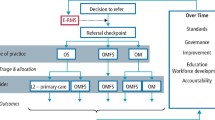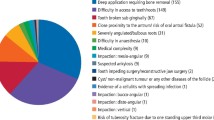Abstract
Introduction This study was designed to investigate the accuracy of clinical information provided by referring general dental practitioners (GDPs) following the introduction of a standardised referral form across Wales (the All Wales Universal Orthodontic Referral Form [AWUORF]) and to see whether the information given could be reliably used to screen the referrals.
Aim To evaluate whether priority cases were being readily identified and whether inappropriate referrals could be minimised, thereby potentially reducing waiting lists.
Method A service evaluation involving the retrospective study of 200 consecutive referrals to a specialist practice over a three-month period. A descriptive data analysis was undertaken.
Results The GDPs had successfully identified the main complaint in 156 (78%) of the referrals. Of the 44 (22%) clinically inaccurate referrals, there was no impact on the patient in terms of referral pathway in 32 (16%) cases, but in the remaining 12 (6%), 5 (2.5%) cases were prioritised unnecessarily and the remaining 7 (3.5%) would have been seen more quickly had the GDP provided the relevant clinical information. The appropriateness of referral in terms of eligibility of the patient to receive NHS-funded orthodontic treatment was high with only 18 (9%) patients failing to meet the criteria.
Conclusion The AWUORF successfully guides the GDP to make appropriate referrals and enables accurate triage in the majority of cases.
This is a preview of subscription content, access via your institution
Access options
Subscribe to this journal
Receive 24 print issues and online access
$259.00 per year
only $10.79 per issue
Buy this article
- Purchase on Springer Link
- Instant access to full article PDF
Prices may be subject to local taxes which are calculated during checkout


Similar content being viewed by others
References
O'Brien K, Wright J, Conboy F et al. The effect of orthodontic referral guidelines: a randomised controlled trial. Br Dent J 2000; 188: 392-397.
North Wales Local Dental Committee. Universal Orthodontic Referral Form. Available at https://www.northwalesldc.co.uk/pdf/universal-orthodontic-referral-form.pdf (accessed September 2019).
O'Brien K, McComb J L, Fox N, Bearn D, Wright J. Do dentists refer orthodontic patients inappropriately? Br Dent J 1996; 181: 132-137.
Reddy S, Derringer K A, Rennie L. Orthodontic referrals: why do GDPs get it wrong? Br Dent J 2016; 221: 583-587.
Lewis B R K, Plunkett D J, Hickman J, Sandham J S. Re-shaping NHS orthodontic provision - the North Wales experience. Br Dent J 2017; 222: 803-808.
Brook P H, Shaw W C. The development of an index of orthodontic treatment priority. Eur J Orthod 1989; 11: 309-320.
Jawad Z, Bates C, Hodge T. Can dental registrants use the Index of Orthodontic Treatment Need accurately? Part 2. Factors influencing knowledge of IOTN among dental registrants. Br Dent J 2016; 220: 591-595.
Jackson O A, Cunningham S J, Moles D R, Clark J R. Orthodontic referral behaviour of West Sussex dentists. Br Dent J 2009; DOI: 10.1038/sj.bdj.2009.979.
Rayner W J, Neal J J D. Pre-assessment triage of orthodontic referrals at an East Yorkshire Hospital. Br Dent J 2008; 204: 493-495.
Mandall N A, O'Brien K D, Brady J, Worthington H V, Harvey L. Teledentistry for screening new patient orthodontic referrals. Part 1: A randomised controlled trial. Br Dent J 2005; 199: 659-662.
Baccetti T, Franchi L, Toth L R, McNamara J J A. Treatment timing for Twin-block therapy. Am J Orthod Dentofacial Orthop 2000; 118: 159-170.
Power S, Short M. An investigation into the response of palatally displaced canines to the removal of deciduous canines and an assessment of factors contributing to favourable eruption. Br J Orthod 1993; 20: 215-223.
Olive R J. Orthodontic treatment of palatally impacted maxillary canines. Aust Orthod J 2002; 18: 64-70.
General Dental Council. Preparing for practice: Dental team learning outcomes for registration (2015 revised edition). Available at https://www.gdc-uk.org/docs/default-source/quality-assurance/preparing-for-practice-(revised-2015).pdf?sfvrsn=81d58c49_2 (accessed May 2019).
Jawad Z, Bates C, Hodge T. Who needs orthodontic treatment? Who gets it? And who wants it? Br Dent J 2015; 218: 99-103.
Jawad Z, Bates C, Hodge T. Can dental registrants use the Index of Orthodontic Treatment Need accurately? Part 1: Knowledge of IOTN among dental registrants. Br Dent J 2016; 220: 527-532.
Chew M T, Aw A K L. Appropriateness of orthodontic referrals: self-perceived and normative treatment needs of patients referred for orthodontic consultation. Community Dent Oral Epidemiol 2002; 30: 449-454.
Acknowledgements
This study was undertaken as part of an MSc dissertation at the University of Warwick.
Author information
Authors and Affiliations
Corresponding author
Rights and permissions
About this article
Cite this article
Ashley, J., Ireland, R. & Plunkett, D. Does the All Wales Universal Orthodontic Referral Form enable accurate triage of new NHS orthodontic patients? A service evaluation. Br Dent J 228, 355–360 (2020). https://doi.org/10.1038/s41415-020-1315-2
Published:
Issue Date:
DOI: https://doi.org/10.1038/s41415-020-1315-2



